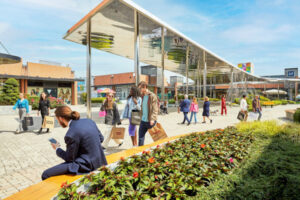By Philipp Sepehr
The current developments in the retail industry, as a whole, and the continuing growth of e-commerce, in particular, pose major challenges to brick-and-mortar retail. These changes also confront shopping centers by questioning their future as retail locations. One promising answer to these challenges is the transformation of shopping centers into omnichannel platforms, an evolution for which they hold both excellent conditions and broad potential.
The changing needs of our customers play a crucial role in this. On the one hand, their demand for increasingly interconnected online and offline channels has to be recognized and executed. Consumers want to freely choose, depending on the product, which channel they use to get information about an item and where to eventually buy it. Currently, studies say that more than 50% of all purchases at brick-and-mortar stores are prepared online in advance. Looking at the products ordered online, however, customers demand free delivery within the shortest possible period of time, but without delivery problems in the final mile. It can quite rightly be questioned whether these demands can be cost-efficiently and logistically met with the existing delivery network of the e-commerce retailers, which is based on large fulfillment centers on the cities’ outskirts.
For shopping centers, this results in a specific need for action through the expansion of their offerings to online channels and via the combination of all brick-and-mortar and digital channels to provide an omnichanneling experience. If consumers look for a product online today, they are usually directed to major e-commerce websites, such as Amazon, even if the product is available in the desired size and color at a nearby shopping center, rendering it quick and easy to get hold of. However, when it comes to the world of online product searches, shopping centers are still a black box. Therefore, if we manage to show the products offered and available at a center, including their prices and current availability at local shops on different online channels, such as center websites, Google, etc., this will result in future potential that can – and must – be exploited.
On the one hand, services such as Click & Collect or Click & Reserve can be converted into brick-and-mortar purchases and, thus, into additional turnover. On the other hand, showing the products available at a center on e-commerce marketplaces such as Amazon or Zalando by linking online and offline platforms will make them serve as so-called micro hubs that deliver the products ordered online to customers. Both effects will increase the productivity of leased spaces and, thus, the commercial success of the shopping center.
One crucial factor is that today’s shopping centers already meet the requirements for transformation into omnichannel platforms: a broad range of products and assortments, an established partnership with brick-and-mortar retailers, the physical vicinity to customers, a good connection to city transport networks, and existing logistical infrastructure. Furthermore, there will be benefits from potential scaling effects as a result of the advantage of the presence of several stores at one location as well as an increase in efficiency with regard to delivery and logistics. ECE has already taken the first step to executing this idea with its “Digital Mall” pilot project: 400,000 products offered by more than 60 shops from five centers are currently available online. A step-by-step expansion of this service and an increase in the number of connected shops and centers are currently being arranged.
After all, the idea seems to be as useful as it is promising: If the transformation of shopping centers into omnichannel platforms turns out to be successful, they will not only reinvent themselves as relevant retail locations, but, at the same time, result in additional benefits for all stakeholders – customers, retailers, and investors alike – and also make an important contribution to the successful future of shopping centers and brick-and-mortar retail.





